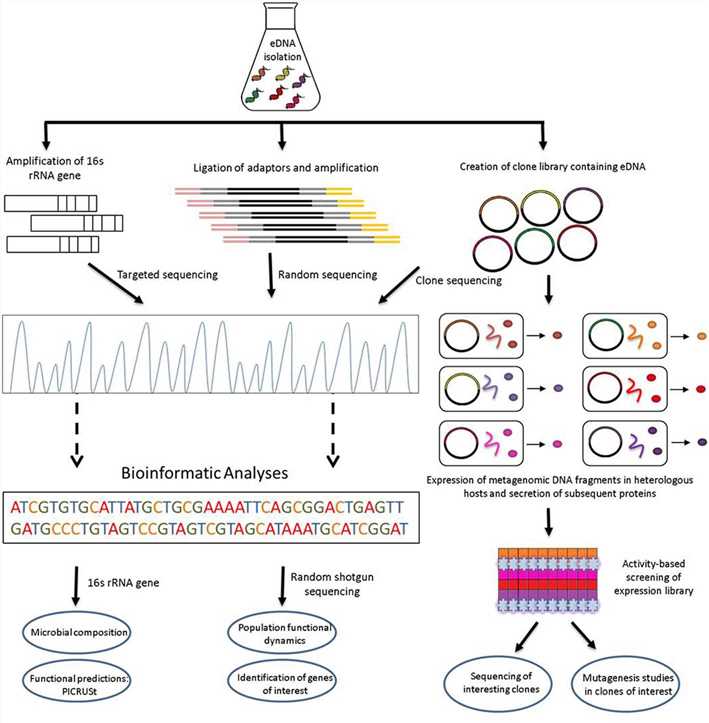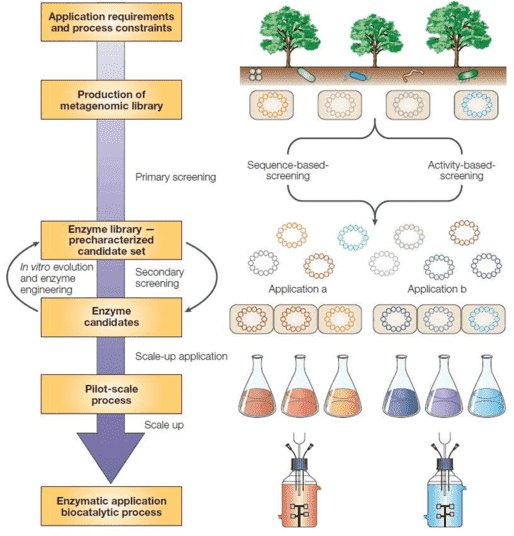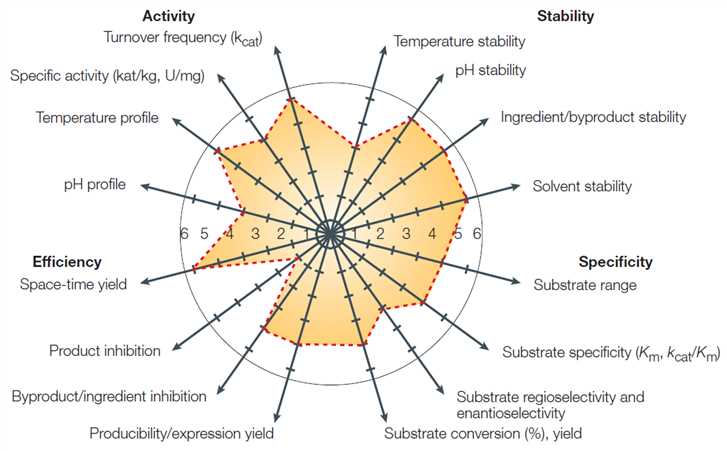Microbes are present almost everywhere. They play a vital role in cycling carbon, release important compounds, and may be associated with infectious diseases. Metagenomics is the culture-independent genomic research of microbial communities. Metagenomics presents a powerful tool to study prokaryotes and viruses in the environment via the analysis of their DNA obtained directly from environmental samples. This technology considers the DNA of microbes in a population as a whole. It can not only identify the microbial of microbial species present but also provide insight into the functional roles and metabolic activities of the microorganisms. The coupling of this method with function-based activity is a powerful technique for the discovery of new functional genes from uncultured microbes.
 Figure 3. Functional metagenomic strategies for the identification of novel biocatalysts and bioactives from environmental samples (Coughlan et al. 2015).
Figure 3. Functional metagenomic strategies for the identification of novel biocatalysts and bioactives from environmental samples (Coughlan et al. 2015).
Biotechnological applications
Currently, there is a global political drive to promote white biotechnology as a key feature of modern industrialized society. Metagenomics has the potential to substantially impact industrial production.
 Figure 1. Industrial enzymes – from the metagenome to applications and processes (Lorenz 2005).
Figure 1. Industrial enzymes – from the metagenome to applications and processes (Lorenz 2005).
Bioactive compounds: Unique bioactive compounds have been identified through metagenomics studies, including terragines, violacein, and indirubin. Drugs originated from marine microorganisms, such as cytarabine (anti-cancer), cephalosporins (anti-microbial), and vidarabine (anti-virus), have been established on the pharmaceutical market.
Antibiotics: Novel antibiotics and enzymes are among the early discoveries from metagenomics. The discovery of streptomycin, turbomycin, and other antibiotics sprang from basic studies of the soil microbiome. Functional metagenomics serves to find novel antibiotics or novel antibiotic resistance genes, and descriptive metagenomics serves to analyze changes in the composition of the microbiome and to track the presence and abundance of known antibiotic resistance genes in different environments.
Enzymes: New genetic information on industrial enzymes, such as lipases, proteases, lyases, amylases, nitrilases, has been produced by metagenomics approaches. Enzymes have a wide range of applications, including the production of highly active pharmaceuticals and active ingredients (such as high-performance laundry detergents). The versatility of industrial enzymes allows their use in the processes to degrade natural polymers such as cellulose, proteins and starch, as well as for the synthesis of asymmetric chemicals.
 Figure 2. Multi-parameter footprint analysis. This figure describes the ideal biocatalyst concept (Lorenz 2005).
Figure 2. Multi-parameter footprint analysis. This figure describes the ideal biocatalyst concept (Lorenz 2005).
Health care
Infections disease. Metagenomics has now been applied to identify an unknown pathogen in outbreaks of disease. Shotgun metagenomics can also be used in the discovery and detection of pathogens in clinical samples. For RNA viruses, RNA isolated from a sample usually need to be converted to cDNA first. In addition to bacterial pathogens and viruses, metagenomics has so far seen a little use in the detection of parasitic infection. For example, Plasmodium and Toxoplasma sequences were found in the metagenome of Egyptian mummies (Khairat et al. 2013). Potential applications of metagenomics in parasitology include recovery of genomic-epidemiological data and determination of the influence of parasites on the microbial ecology in the gut.
Gut health. 16S/18S/ITS amplicon sequencing is a powerful and affordable tool for clinical microbiota analysis. It can be used to determine gut microbial species and their abundance, and allows to monitor human health and well-being. Metagenomics sheds the light into the development of probiotics. Monitoring of human-associated bacterial communities allows to establish ways to modulate them, so as to optimize human health. Personalized metagenomics has been on the market and is available for purchase. It is always better to prevent than to treat. And personal metagenomics, in conjunction with personal genomics and epigenomics, may be the foundation of the health care of tomorrow.
Wildlife conservation
Microbial ecology and next-generation sequencing offer valuable perspectives and tools for investigating and monitoring wildlife health. The microbial communities inhabiting animals and plants profoundly affect host health, nutrition, physiology, and immune systems. DNA sequencing technologies allow us to identify microbiomes among and within hosts. Microbial communities are sensitive to changes in the external environment, and microbial diversity correlates with habitat quality. Therefore, incorporating microbial host and biogeographic variation holds great potential for forest corridor assessments and reintroduction efforts. Additionally, microbial pathogens posit a great threat to wildlife health.
References:
- Coughlan L M, Cotter P D, Hill C, et al. Biotechnological applications of functional metagenomics in the food and pharmaceutical industries. Frontiers in microbiology, 2015, 6: 672.
- Ehrlich S D. Metagenomics of the intestinal microbiota: potential applications. Gastroenterologie clinique et biologique, 2010, 34: S23-S28.
- Khairat, R., et al. First insights into the metagenome of Egyptian mummies using next-generation sequencing. Journal of Applied Genetics, 2013 (54): 309–325.
- Lorenz P, Eck J. Metagenomics and industrial applications. Nature Reviews Microbiology, 2005, 3(6): 510.
- Pallen M J. Diagnostic metagenomics: potential applications to bacterial, viral and parasitic infections. Parasitology, 2014, 141(14): 1856-1862.
- Schloss P D, Handelsman J. Biotechnological prospects from metagenomics. Current opinion in biotechnology, 2003, 14(3): 303-310.
- Stumpf R M, Gomez A, Amato K R, et al. Microbiomes, metagenomics, and primate conservation: New strategies, tools, and applications. Biological Conservation, 2016, 199: 56-66.
- Wong D W S. Applications of metagenomics for industrial bioproducts[J]. Metagenomics: theory, methods and applications, 2010: 141-158.
For research purposes only, not intended for clinical diagnosis, treatment, or individual health assessments.


 Sample Submission Guidelines
Sample Submission Guidelines
 Figure 3. Functional metagenomic strategies for the identification of novel biocatalysts and bioactives from environmental samples (Coughlan et al. 2015).
Figure 3. Functional metagenomic strategies for the identification of novel biocatalysts and bioactives from environmental samples (Coughlan et al. 2015).  Figure 1. Industrial enzymes – from the metagenome to applications and processes (Lorenz 2005).
Figure 1. Industrial enzymes – from the metagenome to applications and processes (Lorenz 2005).  Figure 2. Multi-parameter footprint analysis. This figure describes the ideal biocatalyst concept (Lorenz 2005).
Figure 2. Multi-parameter footprint analysis. This figure describes the ideal biocatalyst concept (Lorenz 2005). 